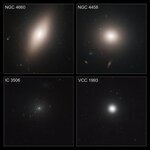Space

A powerful collision of galaxy clusters has been captured with NASA's Chandra X-ray Observatory and Hubble Space Telescope. Like its famous cousin, the so-called Bullet Cluster, this clash of clusters provides striking evidence for dark matter and insight into its properties.
Like the Bullet Cluster, this newly studied cluster, officially known as MACSJ0025.4-1222, shows a clear separation between dark and ordinary matter. This helps answer a crucial question about whether dark matter interacts with itself in ways other than via gravitational forces.
Credit: X-ray(NASA/CXC/Stanford/S.Allen…

How do galaxies form? The most widely accepted answer to this fundamental question is the model of 'hierarchical formation', a step-wise process in which small galaxies merge to build larger ones. One can think of the galaxies forming in a similar way to how streams merge to form rivers, and how these rivers, in turn, merge to form an even larger river.
This theoretical model predicts that massive galaxies grow through many merging events in their lifetime. But when did their cosmological growth spurts finish? When did the most massive galaxies get most of their mass?
Composite colour-image…

The systematics of celestial bodies needs to be revised, say researchers at the Argelander Institute of Astronomy of the University of Bonn. Brown dwarfs, to-date merely regarded as stars which were below normal size, may well be stellar ‘miscarriages' and need to be treated as a separate class in addition to stars and planets.
Brown dwarfs (or BDs) are what scientists call objects which populate the galaxies apart from the stars. Unlike the latter, they cannot develop high-yield hydrogen fusion as in the interior of our sun due to their low mass (less than about 8% of the sun’s mass). But in…

The mystery of how young stars can form within the deep gravity of black holes has been solved by a team of astrophysicists at the Universities of St Andrews and Edinburgh.
The team, partly funded by the Science and Technology Facilities Council (STFC), made the discovery after developing computer simulations of giant clouds of gas being sucked into black holes. The new research may help scientists gain better understanding of the origin of stars and supermassive black holes in our Galaxy and the Universe.
Until now, scientists have puzzled over how stars could form around a black hole,…

NGC 1275 is one of the closest giant elliptical galaxies and lies at the centre of the Perseus Cluster of galaxies. It is an active galaxy, hosting a supermassive black hole at its core, which blows bubbles of radio-wave emitting material into the surrounding cluster gas. Its most spectacular feature is the lacy filigree of gaseous filaments reaching out beyond the galaxy into the multi-million degree X-ray emitting gas that fills the cluster.
These filaments are the only visible-light manifestation of the intricate relationship between the central black hole and the surrounding cluster gas.…

Unlike many astronomical phenomena, meteors are best seen with the unaided eye rather than through a telescope or binoculars and are perfectly safe to watch, so be prepared to sleep outside on August 12th, the annual maximum of the Perseid meteor shower.
In doing so, you will be joining your ancestors, who have viewed what are also called "The Tears of St. Lawrence"(1) for some 2,000 years.
Meteors are the result of small particles entering the Earth’s atmosphere at high speed and in the case of the Perseid shower these come from the tail of the Comet Swift-Tuttle, which was last in the…

We don't have spacecraft to take us outside our solar system but astronomers have still been able to develop a good understanding of how our solar system formed and in turn, how others formed. In the last dozen years, the nearly 300 exoplanets have been discovered have added to our knowledge base.
Conventional knowledge said most solar systems were like our own but three Northwestern University researchers questioned that assumption and explored the question in detail. What they learned is that the solar system in which the Earth orbits our sun is actually uncommon.
Edward Thommes, Soko…

Nihilist types, and even prevailing theoretical models, attempting to explain the formation of the solar system have assumed it to be average in every way but a new study by Northwestern University astronomers that used recent data from the 300 exoplanets discovered orbiting other stars turns that view on its head.
Our solar system is pretty special and if early conditions had been just slightly different planets could have been thrown into the sun or jettisoned into deep space.
Using large-scale computer simulations, the Northwestern researchers are the first to model the formation of…

When Yale astrophysicist Kevin Schawinski and colleagues at Oxford University enlisted public support in cataloguing galaxies, they never envisioned the strange object Hanny van Arkel found in archived images of the night sky.
The Dutch school teacher, a volunteer in the Galaxy Zoo project that allows members of the public to take part in astronomy research online, discovered a mysterious and unique object some observers are calling a "cosmic ghost."
When van Arkel posted about the image that quickly became known as "Hanny's Voorwerp" ( Dutch for "object") on the Galaxy Zoo forum,…

Globular star clusters, dense bunches of hundreds of thousands of stars, contain some of the oldest surviving stars in the Universe. A new international study of globular clusters outside our Milky Way Galaxy has found evidence that these hardy pioneers are more likely to form in dense areas, where star birth occurs at a rapid rate, instead of uniformly from galaxy to galaxy.
Astronomers used the NASA/ESA Hubble Space Telescope to identify over 11 000 globular clusters in the Virgo cluster of galaxies, most of which are more than 5 billion years old. Comprised of over 2 000 galaxies, the…